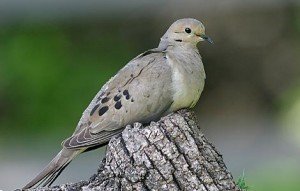The Great Qualities of Mourning Dove
The Mourning Doves are exceptional birds with exceptional qualities of great interest. It may intrigue you to know that they are sometimes mistaken for Pigeon. I already knew, and maybe you did too, that mourning doves will sometimes hang around our cold, warm if there is food—that is, if we keep our bird feeders stocked. My thoughts turned to this as I watched from the window as a pair of them scooped up some spillage off the ground below one of our backyard feeders.
They’re still here, and I resolved to help them stay around, to keep it full. Though most people think their cooing call sounds sad, I actually find the sound of it somehow comforting.
The following qualities are very peculiar attributes of mourning doves you may also appreciate.
When seeds are grabs from the ground, they are not necessarily eating them. Instead, they are stockpiling them in the crop (which is simply an enlarged part of their esophagus) for digestion later.
They are primarily seed-eaters, not insect-eaters. They can and do eat weed seeds, which is certainly valuable to gardeners as well as farmers, or anyone living near overgrown vacant plots.
The cooooOOOOO-woo-woo-woo call is almost always uttered by the male bird, not the female, and is—wait for it—a wooing call, an enticement to a mate or potential mate.
When they sleep, their head rests between their shoulders, close to the body which do not tuck their little heads under their shoulder feathers, like a lot of other birds do.
Their long, pointed wings are almost falcon-like in appearance, while their pointed tails are longer than those of any other doves. These “design features” enable the birds to fly fast.
When they lay eggs, it is almost always just two. (Singletons are rare, as are bigger clutches.). With Incubation period of about two weeks.
Males and females work together to feed their new babies something called “crop milk” or “pigeon milk” for the first few days of their life. Rich in protein and fat, it resembles cottage cheese, is secreted by the adults’ crop lining, and is regurgitated to the little ones. Weaning is fast, though—by the fourth day of life, the diet starts to segue to seeds, and by two weeks, the youngsters are nearly fledged.
Mourning doves are considered closely related to the late, lamented passenger pigeons (Ectopistes migratorius), an extinct species of pigeon that was endemic to North America.
These doves are still hunted in many areas. However, I have not come across record showing population decline.
Pairs tend to mate for life. Another name for them is “turtle doves.” So, small wonder that the author of the favorite Christmas song kept them as a pair. (Besides, “a mourning dove in a pear tree”)
Reference
https://en.wikipedia.org/wiki/Mourning_dove
http://www.birdsandblooms.com/blog/10-surprising-facts-about-mourning-doves/
